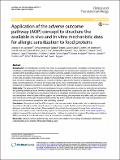Por favor, use este identificador para citar o enlazar a este item:
http://hdl.handle.net/10261/149725COMPARTIR / EXPORTAR:
 SHARE SHARE
 CORE
BASE CORE
BASE
|
|
| Visualizar otros formatos: MARC | Dublin Core | RDF | ORE | MODS | METS | DIDL | DATACITE | |

| Título: | Application of the adverse outcome pathway (AOP) concept to structure the available in vivo and in vitro mechanistic data for allergic sensitization to food proteins |
Autor: | Bilsen, Jolanda H. M. van; Lozano-Ojalvo, Daniel CSIC ORCID; Molina, Elena CSIC ORCID ; Roggen, Erwin L. | Palabras clave: | Adverse outcome pathway Key events Key event relations Food allergy Sensitization Mechanistic understanding Food proteins Molecular initiating event |
Fecha de publicación: | 12-may-2017 | Editor: | BioMed Central | Citación: | Clinical and Translational Allergy 7(1): 13 (2017) | Resumen: | [Background]
The introduction of whole new foods in a population may lead to sensitization and food allergy. This constitutes a potential public health problem and a challenge to risk assessors and managers as the existing understanding of the pathophysiological processes and the currently available biological tools for prediction of the risk for food allergy development and the severity of the reaction are not sufficient. There is a substantial body of in vivo and in vitro data describing molecular and cellular events potentially involved in food sensitization. However, these events have not been organized in a sequence of related events that is plausible to result in sensitization, and useful to challenge current hypotheses. The aim of this manuscript was to collect and structure the current mechanistic understanding of sensitization induction to food proteins by applying the concept of adverse outcome pathway (AOP). [Main body] The proposed AOP for food sensitization is based on information on molecular and cellular mechanisms and pathways evidenced to be involved in sensitization by food and food proteins and uses the AOPs for chemical skin sensitization and respiratory sensitization induction as templates. Available mechanistic data on protein respiratory sensitization were included to fill out gaps in the understanding of how proteins may affect cells, cell–cell interactions and tissue homeostasis. Analysis revealed several key events (KE) and biomarkers that may have potential use in testing and assessment of proteins for their sensitizing potential. [Conclusion] The application of the AOP concept to structure mechanistic in vivo and in vitro knowledge has made it possible to identify a number of methods, each addressing a specific KE, that provide information about the food allergenic potential of new proteins. When applied in the context of an integrated strategy these methods may reduce, if not replace, current animal testing approaches. The proposed AOP will be shared at the www.aopwiki.org platform to expand the mechanistic data, improve the confidence in each of the proposed KE and key event relations (KERs), and allow for the identification of new, or refinement of established KE and KERs. |
Versión del editor: | http://dx.doi.org/10.1186/s13601-017-0152-0 | URI: | http://hdl.handle.net/10261/149725 | DOI: | 10.1186/s13601-017-0152-0 | ISSN: | 2045-7022 |
| Aparece en las colecciones: | (CIAL) Artículos |
Ficheros en este ítem:
| Fichero | Descripción | Tamaño | Formato | |
|---|---|---|---|---|
| 13601_2017_Article_152.pdf | 2,06 MB | Adobe PDF |  Visualizar/Abrir |
CORE Recommender
PubMed Central
Citations
9
checked on 31-mar-2024
SCOPUSTM
Citations
29
checked on 23-abr-2024
WEB OF SCIENCETM
Citations
25
checked on 23-feb-2024
Page view(s)
347
checked on 24-abr-2024
Download(s)
270
checked on 24-abr-2024

